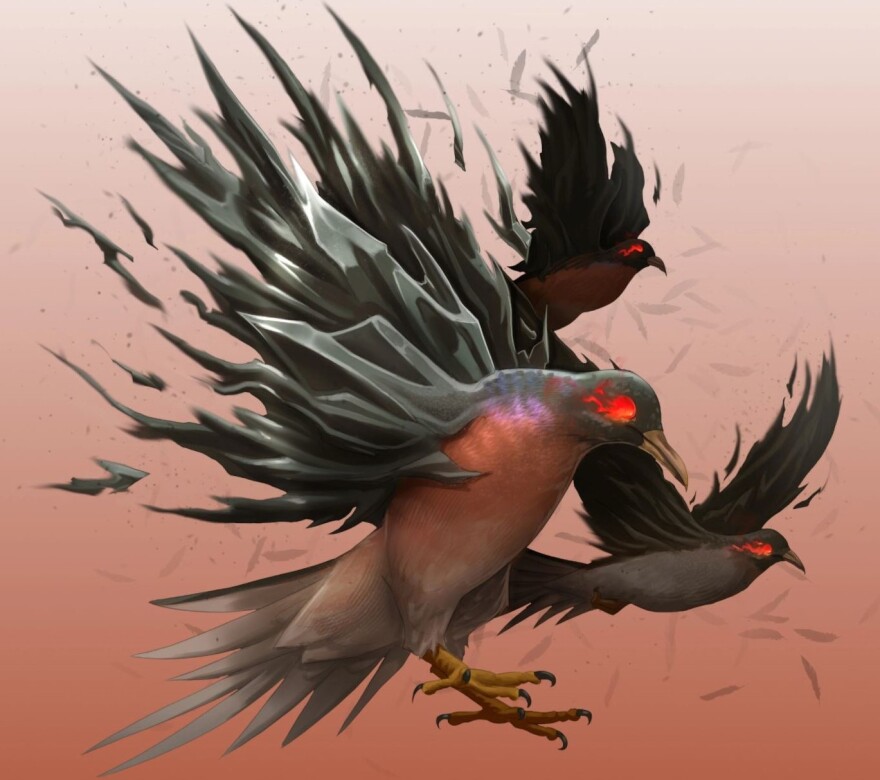John Hanna is leading a group of friends on a Dungeons and Dragons adventure. Once a week, they meet at Epic Loot, a game shop in Centerville, where they sit at a big table, rolling dice and making up fantabulous stories.
“So, as you’re tromping through the swamps, you notice that there’s an inn,” Hanna says. “And you notice that it’s moving. So, you've got a building with legs.”
And Hanna and his friends aren't’ alone in wanting to role play. James Harrington, who works at Epic Loot, says there’s a waiting list.
“Right now, I think there’s, I want to say in the thirties, on a waiting list of people who want to play again,” he says.
The shop has a big play room and they offer many different types of games, but Dungeons & Dragons is often an entry point because of its popularity, and Harrington says, it’s also just a ton of fun.
“If you want to be the hero in adventures, you can be that. If you want to be someone who creates spells, you can do that. It gives you a lot of variety. If you want to have a pet dinosaur and go on adventures with that dinosaur, you can do that. It’s a lot of freedom,” Harrington says.
The group playing tonight doesn’t have a pet dinosaur, but they have created a garden creature the size of an elephant.
“We’ve got a snail, and they’ve named it Flash, which immediately brought out the pop culture reference and the song.”
Elizabeth Lehner is part of this team traveling through imaginary swamps with Flash the snail. She’s been playing for over a decade, and she says the game has staying power because of its diverse appeal.
“I think the nice thing is that a bunch of different people can sit at the same table playing the same game and get different things out of it and find it fulfilling,” she says. “So, one person may enjoy the tactics of battle. Someone else may just enjoy sitting with friends and making stupid jokes. Another person may enjoy inhabiting their character and getting into that role play and improv. That's what's great about D&D. It’s for different people but you can all come together to do it.”
And “D&D” is inspiring local writers, too.

Lucas Zellers is working on a monster manual for Dungeons & Dragons players, but Zellers’ beasts are all animals that really did exist on earth at one time… and have since gone extinct.
Some of them have local connections.
“The passenger pigeon was the most populous, the most numerous life form that has arguably ever existed on this planet,” Zellers says. “There were literal billions of them in North America at the time of European settlement. By 1914, there was one. Her name was Martha. She died at the Cincinnati Zoo on September 1. We know the day and the date and the time and the place of the extinction of a species that once would blot out the sun for days at a time.”
Another species in his monster manual is the Great Auk, a giant flightless waterfowl, much like a penguin, which lived on Eldey Island in Iceland. They were widely hunted by Northern fishermen for their meat, their feathers, their eggs… And Zellers says we know exactly when they went extinct, too.
“June 3rd, 1844. A party of three fishermen entered Eldey Island to find the last living pair of Auks for a foreign merchant. These three fishermen strangled the two adults and crushed the last egg beneath their boots. And that’s how they went extinct,” he says. “We have a first hand account of what that was like, and it’s bone chilling.”
In a twist, Zellers says an area where Great Auks used to live is now a nature preserve where thousands of similar birds, like puffins, go to nest each year.
And Zellers hopes his monster manual inspires others to become conservationists. If humans had the power to make these species disappear, he reasons we can raise awareness and save species too
“The choices that we make can create ecosystems and ecologies that support greater biodiversity, and one of the best ways to start doing that is to do what D&D players do best, which is tell stories about them. If you’re bringing these creatures in your game, they’re going to be alive in a way they otherwise never could have been.”
Zellers is still working on the monster manual, which is called the "Book of Extinction," but there is a preview available online and it's being used to help raise funds for the Center for Biological Diversity.
Support for Culture Couch comes from WYSO Leaders Frank Scenna and Heather Bailey, who are proud to support storytelling that sparks curiosity, highlights creativity and builds community.
Culture Couch is created at the Eichelberger Center for Community Voices at WYSO.


